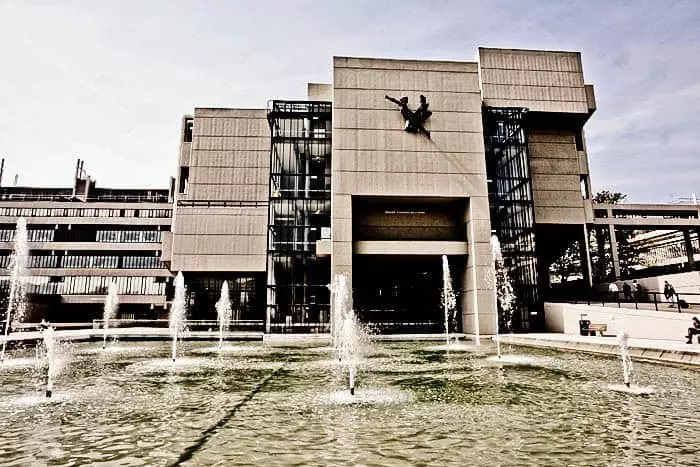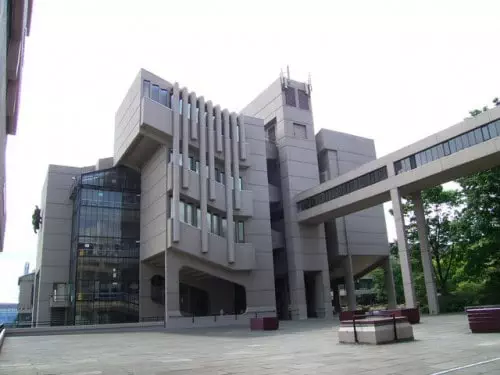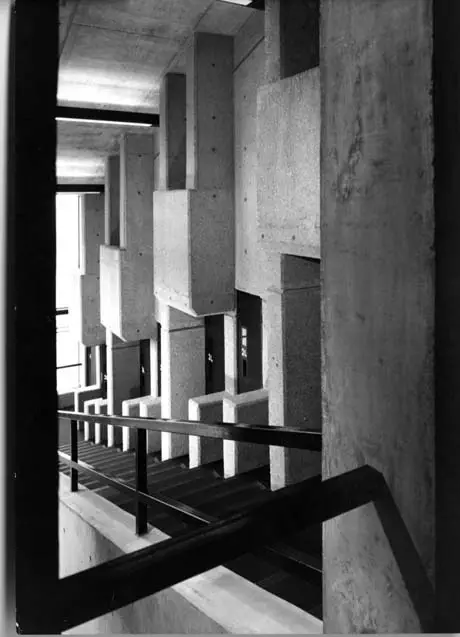Beautiful Brutalism
Post by guest blogger Jayne Rodgers

Photo: Paul Bye
Leeds is home to one of the finest examples of Brutalist architecture in the UK. Seriously. The Roger Stevens Building sits on the southern edge of the University of Leeds campus. It has a fountain and a sculpture and if that’s not enough to impress, it’s a Grade II* listed building. I know, cool for a building that some people think is hideous, right?
The Roger Stevens is actually a quite beautiful building but the expanses of glass and concrete characteristic of Brutalism are generally pretty divisive. Brutalism tends to be a love it or hate it style of architecture and, to be fair to the haters, the Roger Stevens is linked by walkways to other interesting but much less attractive 1970s buildings, meaning that it tends not to be seen for its own merits.
So let’s look at the Roger Stevens as a beautiful building in its own right. It was named after a former British diplomat who served in Buenos Aires, New York and Antwerp, among other places. Did they commemorate him though? Oh no. It was left to Leeds, where he was Vice-Chancellor of the university in the 1960s, to do this.
The building was designed by the architects Chamberlin, Powell and Bon and completed in 1970. They also did the Barbican and the groundbreaking Golden Lane Estate in the City of London, which is widely considered a great model for urban living. We’re in good company here.

Photo: Stanley Walker
English Heritage says “the building is an outstanding and individual design with bold external shapes and carefully designed interiors.” That doesn’t tell us the half of it though. Brutalism, pioneered by architect and designer Le Corbusier, tended to put the concrete on the outside rather than using it purely for infrastructure, hence the dislike of its style for some people. It’s characterized by angular, repeated shapes and often has a lot of windows and open plan spaces. The design also emphasizes functionality. In short, it’s sparse, unfussy and often, well, quite brutal.
Two features of the building contradict the standard Brutalist aesthetic. One is the large bronze sculpture of a floaty, ethereal woman on the side of the building by Quentin Bell, nephew of Virginia Woolf, and a born member – quite literally – of the Bloomsbury Set. The other is the fountain, which is there for visual rather than functional purposes. In this sense, some of the harder aspects of ‘classic’ Brutalism are tempered.

Photo: University of Leeds archive
These features aside, the Roger Stevens is 100% bona fide, straight up Brutalist. It’s made of concrete (of course), with hundreds of tall, narrow windows, many of them mirrored. My former office on the ground floor – which, somewhat confusingly, was called Level 5 – had windows running the full width of the room. The café upstairs – first floor, aka Level 6! – is glass-walled, with windows in the corners that run the full height of the building to let the light flood in on its fixed concrete and oak bench tables. The lecture theatres, which lead off long, low stairways have individual doors into the rows of seats, meaning that lectures are not interrupted by latecomers. It does also mean that your students all tend to huddle on one side of the room but I found the crick I got in my neck lecturing there a small price to pay for teaching in my all-time favourite building.
Studying at Leeds University in the 1970s, I was scared of the paternoster (the open-sided lift which never stopped but moved round in a loop) which was the situated in the centre of the Roger Stevens Building. There were many urban myths associated with these lifts which were a feature of several university buildings around the country. The myths chiefly concerned what happened at the top and bottom of the lifts’ run. Some people said they crushed flat whilst others said they turned the other way up, doing a head-over-heels. Either way, death or serious injury was virtually guaranteed. Only the brave rode to the top of the paternoster to engage in potentially life-threatening empirical research.
At the time we also believed that the water in the pool was toxic and so one shouldn’t throw one’s friends in….
Helen
I seem to remember being told by the very clever @jiffyjen that the pool with the fountains is ingeniously part of the air conditioning and heating system. I’ll try and get her tell more!
Ed x
Ooh, yes, do ask clever Jen to provide further info. The pool was always a bit of a mystery. The cooling system developed a fault once and flooded my (ground floor/level 5) office. Totally destroyed everything I didn’t need and left everything I did! That building is genius, I tell you…
Wow, that brings back memories. I studied at Leeds in the 1990s, and this building was somewhere I spent plenty of time going to lectures and meeting with friends. I always remember people referring to the fact that an episode of Dr Who was filmed there, so futuristic did it look.
Having often been lectured in this building I am happy to see it praised.
An interesting aspect not touched upon is the evolution of these buildings. The once dank looking concrete is now painted over in beige – inauthentic, I am sure, but less grim. The lecture theatre windows are now actually mirrors – it looks shinier and works better inside with the heat/glare gone.
It is still ridiculously badly designed for getting thousands of students in and out promptly. And as mentioned the rest of the 70s design is rubbish – no other buildings open out at ground level so the open space is underused and the narrow corridor in the sky rammed. What could be a focal point of the university is left out on a limb far from library or union.
But, far more importantly, wasn’t it Blake’s Seven that was filmed there?
As a seventeen year old schoolboy in Leeds,I wrote my “A” level Art study about this building. I’d fallen in love with the complex interior – at the time it felt like walking into the future. I tracked down many of the people who’d worked on it and spoke to, or corresponded with, them.
The pool outside didn’t originally have any fountains and was supposedly a necessary part of the air conditioning (I think). The building was called “Brutalist” – but when I saw the perpetrations of real Brutalists, I realised that the architects had had too much fun playing with the shapes and that there was too much whimsy for such a tag.
The paternoster lift was shut down for a long time, after a nasty accident with another one somewhere else.
The sculpture on the aspect in the photograph is a disappointing addition. I can see that that wall is a promising site for a sculpture, but I think that something with a bit of humour like a Tinguely kinetic machine would be more in keeping; for a long time in the early 1970s there was a neat bit of graffiti lower down that read “Brain Factory.”
(Is this spell check set on U. S. English?)
Jayne, didn’t know you had the vision (or the time) to appreciate slabs of engineering. Aah, the hallowed concrete walls of the RS.
Going all the way on the paternoster – not for the heavy set or those of uncertain disposition. Is it still up & running, as I haven’t visited for a while?
The empty, almost abandoned echoes of the transients, blissfully unaware of their presence deep in the heart of this diamond in the rough. Visited & passed through but never journeyed to…
Obviously, the wisdom of maturity excercised by Ms Rodgers to step back & assess – realise & appreciate. Or perhaps you have always been a devotee?
Yes, it’s certainly not to everyone’s taste but definitely overlooked & unappreciated. In fact, not even overlooked! As most of it’s millions of visitors experienced it from within, probably unaware of the time & effort, form & functionality put into it’s creation.
Uncaringly ignorant of the move from the soulless prefab Red Route or the trudge from the car park or the Faversham to this aesthetic icon. It’s immediate surroundings providing it’s very penance!
Brutal indeed.
The paternoster was gone by the time I taught there. Probably for the best – I’d more than likely still be going round in circles on it!
A friend told me that when she worked in a courthouse built in the same style, they were told to refer to the concrete as ‘Swedish stone’ if anyone mentioned it. The beige paint definitely softens the tone.
I recognize the problem of filter 000s of students into the lecture theatres; I used to have to fight my way through them to get to classes. The landings between the rooms are small – I think that’s the problem. That and the fact that students love to loiter…
I have always loved this building though; its aesthetic appeal far outweighs any shortcomings for me.
Of course, we lost one of the greatest brutalist buildings recently. The Poulson-designed International Pool was a fantastic example, and it’s a tragedy that it was allowed to be demolished. They haven’t even done anything with the space.
If it were in Berlin or somewhere, it would have been turned into a concert hall or something.
Nice article
Beautiful to see and beautiful to sit in (if a bit touchy for those with vertigo- but that’s true of a lot of auditoriums- the old Aldwych gods nearly made me scream)
Leeds is a city of inspiring concrete and I’ve always enjoyed the Woodhouse lane car park. I just hope they don’t screw it up with the revamp
I do like The Roger Stevens Building and it is good to see others do to, Leeds Uni has a fine selection of buildings in various styles, new & old.
Yes the pool was originally used as part of the cooling system for the building, quite forward thinking at the time although I suspect it may have been updated at some point and now no longer used for this.
It was Dr Who that was filmed there, Blake 7 was filmed at Leeds Mets now demolished Brunswick building, now the site of the Leeds Arena.
It feels reading the above that RS building suddenly appeared out of the ‘Ugly Bin’ tantalisingly dressed in beige. Chamberlin Powell and Bon seem to have had a good time with the possibilities for spatial acrobatics that concrete, large volume spaces and multiple levels affords. The ‘honesty’ about using ‘exposed’ materials and show them unadorned was always going to end them in the publics “Ugly Bin’. As a series of spaces and interacting levels its hard to beat for excitement and mild or strong disorientation (though maybe that adds to the excitement). After a while you get used to the slightly menacing feel of the exposed concrete and thin black metal frames of the windows. I seem to remember a lot of wired glass on the interior partition glazing that adds to that utilitarian feel.
The squeeze on circulation areas could have been a budgetary thing (or maybe some misguided idea about increasing interaction between students and lecturers). Movement around the campus was a big thing in the master plan design for the university’s redevelopment in the 60’s – as also for York, UEA campuses. I think they never envisaged the future expansion in student numbers.
Great to hear about the pool and the cooling system. This was typical of some of the more adventurous though not otherwise very energy conscious buildings of the 50’s and 60’s (Royal Festival Hall originally used water from the Thames to cool the main auditorium).
Here’s a link to Tina Richardson’s unique film of the campus taking in RS building http://www.youtube.com/watch?v=J_AYOU86AQA&feature=related
Great stuff now lets move on to the groovey Yorks Post Building
The paternoster was working when I attended my university interview/open day early in 1989, but was disappointingly out of commission by the time I arrived to study in October of that year (a later consolation was the paternosters I got to use in my employer’s Warrington office, which were only taken out of service about 3 years ago). I believe they still have working paternosters at Sheffield uni (Wikipedia will tell you more).
I am a big fan of the RS, and sad to have lost the Brunswick. Some of this stuff is worth keeping.
JF
The paternoster was great fun. You were faced by two streams of cubicles, one going up and the other going down. Each cubicle could hold two people. The movement was continuous, you and possibly a partner simply hopped on and hopped off at the appropriate moment. Quick and convenient, it was an integral part of the transport system in the RS building. At the top and the bottom, the cubicles simply slid sideways. However, it was not uncommon for a student to invite visitors to stand back and watch as he hopped on the up-going cubicle, then did a handstand as the cubicle went over the top, providing an interesting spectacle on the down-going side.
Sadly, the paternoster was closed after an accident allegedly involving a bicycle…
The Darwin Awards come to mind.
After several years of being boarded up, the paternoster was replaced by a conventional lift, which is much slower than its predecessor, but is compliant with current equality legislation.
Beautiful building.
I can confirm the lifts were put out of action by a bike.
It was my bike. Momentary lapse of judgement.
Thanks to a friend for sending me the link to this site.
Peter
Nice post. I put you in google rss reader now so I can read more from you again.
Made me think of this poem by Paul Farley called ‘Brutalist’ https://m.facebook.com/YoungPoetsNetwork/posts/200075283348813
Nice piece about a building I didn ‘t know sis. Tainan went to primary school in Golden Lane estate and we often walked through Barbican on our way. Great buildings and spaces.
*like*
xx
i was at leeds 1976 to 83 and remember the paternoster well. we often had a contest to see how many we could get in. i think five was the most. we went over the top many times but were always nervous about underneath. we also got stuck with three going over the top….thats for four hours! leeds security was waiting for us when it was restarted. see leeds rag 1977. got us all into loads of hot wAter. ah the memories of leeds. i did my phd in stead house that lay directly opposite RS onthe other side of the pool……fond memories. is it still there? not been to leeds for 30 years….thanks for the article
I remember a secret kiss with a lovely lad from London in 1986 as the two of us went up and around and over the top in the paternoster. Neither of us knew what might happen as it went round the top, but the thrill was well worth it.